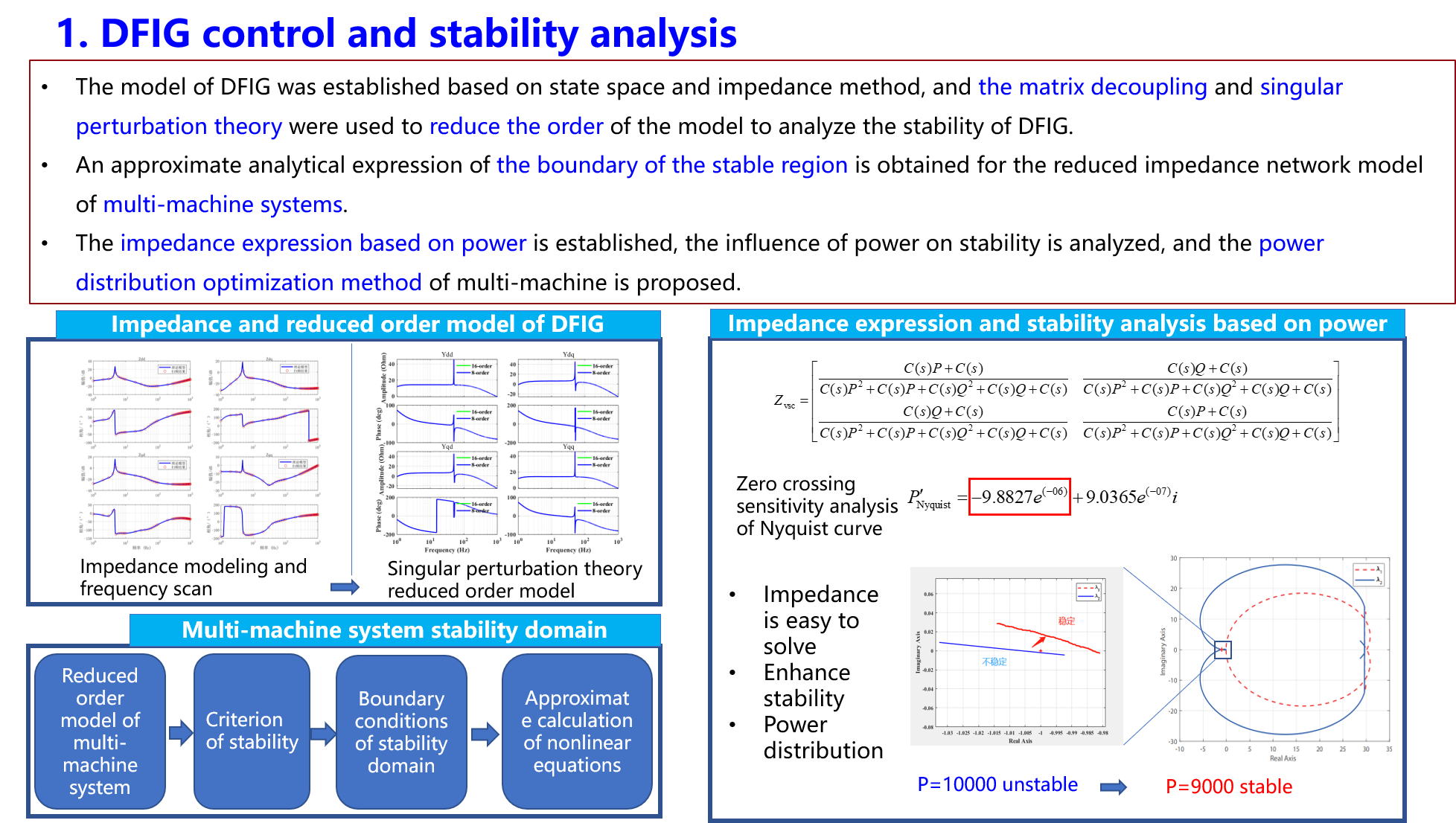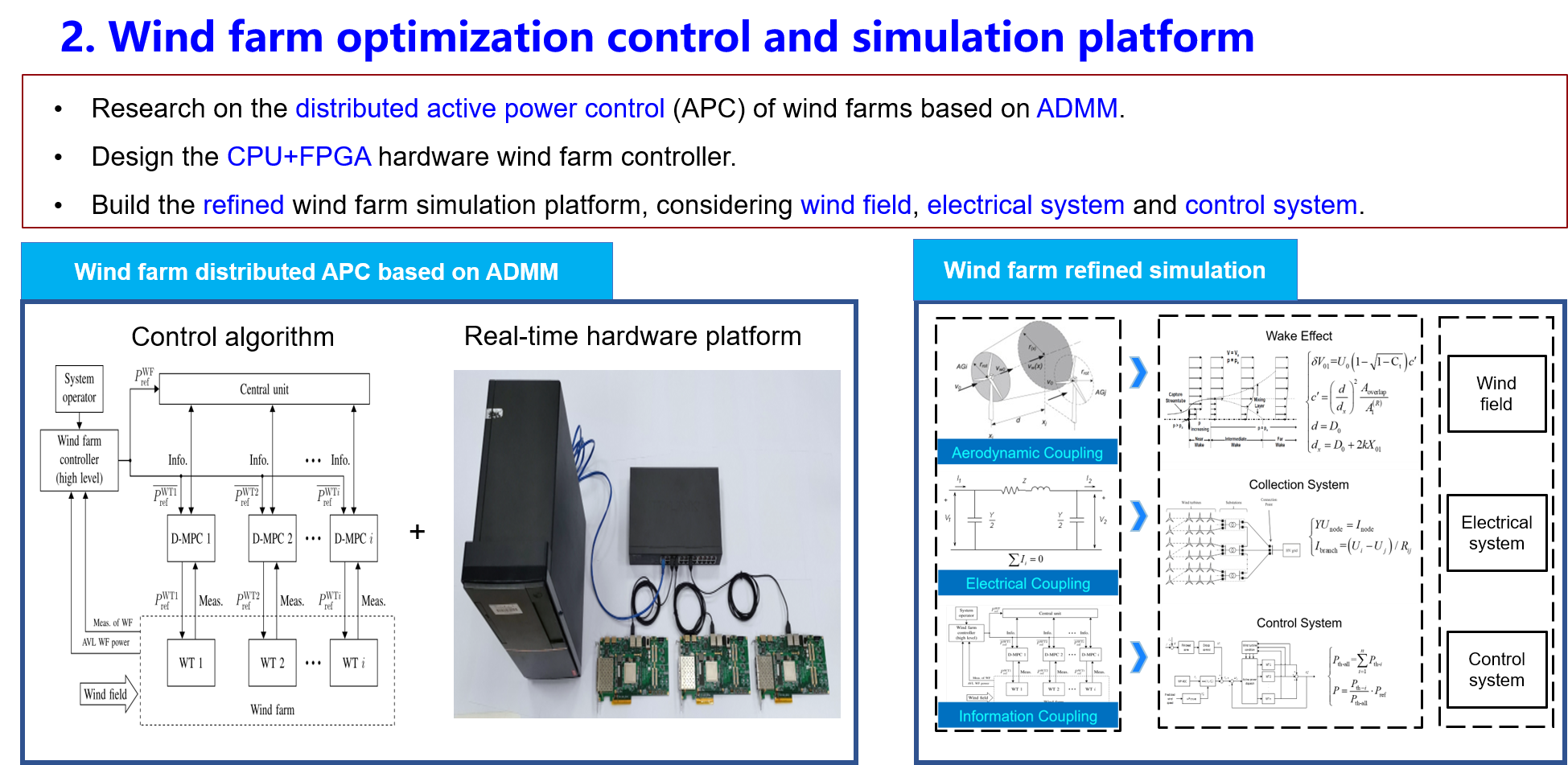
Study on the stability of connecting wind farm to large-scale power grid: For multi-machine system and multi-machine equivalent system of wind farm, an impedance network model based on single-machine reduced impedance model is established. According to the system structure and impedance form, the suitable stability criterion is selected, and the boundary conditions of small signal stability region are obtained. By approximate calculation of nonlinear equation, the approximate analytical expression of stability domain boundary of multi-machine system is obtained. The method to improve the stability margin is given, and the grid is supported actively by changing the grid-connected impedance characteristics through wind farm control. The simulation results are verified in the fully refined real-time wind farm simulation platform.

Wind farm optimization control and platform simulation research: The distributed model predictive control is applied to the wind farm active power optimization control, the causes mechanical fatigue aggravation can be effectively reduced; design The wind farm hardware controller to provide a hardware platform for hardware-in-the-loop testing; build the refined simulation platform for wind farms, and consider the multi-physics coupling between wind farms in detail. In addition, an interface model suitable for the parallel connection of wind turbines is proposed to provide a basis for subsequent real-time simulation.
Introduction to Wind Farm Digital Twin System

Significant progress:
The first achievement is energy consistency scaling theory and model validation based on generalized entropy.By summarizing and comparing, "entropy" is generalized in the multiple energy system as a unified scale to facilitate the consistent expression of heterogeneous energy quantity and quality. Generalized entropy flow is the product of mass flow and specific entropy. Mass flow can reflect flow, and specific entropy can reflect heat. Therefore, generalized entropy flow can better describe the energy flow. The second achievement is the efficient modeling and computing method for multiple energy flow calculation of integrated energy systems (IES). The multiple energy flow calculation model of IES has strong nonlinear characteristics. As a result, it is challenging to balance the accuracy and calculation (convergence) speed. Therefore, for energy flow calculation, optimal energy flow calculation, distributed optimization, and other scenarios, we propose an efficient modeling solution method for multiple energy flow calculation. The third achievement is the artificial intelligence based non-intrusive detection method for IES. In terms of non-intrusive monitoring of port energy, the hybrid neural network is used to mine potential connections in multiple energy data, and semi-supervised learning is used to reduce data dependence. In terms of state estimation, knowledge-guided and data-driven methods are used to extract spatio-temporal correlation information from the measurement data of IES. The fourth achievement is the coupling model and optimization strategy of the information-energy system based on correlation characteristics. This research focuses on considering the resilience optimization of the information layer in IES and mainly solves the problem that the coupling information network is affected when its physical structure is damaged.

At present, large-capacity wind turbines have become the primary trend, and large-capacity wind turbines have the problem of high operation and maintenance costs. By building a wind turbine digital twin system, the intellectual level of operation and maintenance of the wind turbine can be effectively improved, thereby reducing the wind turbine's accident rate and function and maintenance cost. This study establishes a high-precision simulation model at the unit level, and a corresponding real-time simulation platform is developed. By extracting the real-time data of the critical operation of the unit and feeding it back to the high-precision simulation model, the state of the virtual model and the physical wind turbine can be synchronized to complete the high-precision virtual mapping of the wind turbine. The data center collects and stores actual unit operation data and comprehensive and comprehensive high-precision simulation data for upper-layer applications such as data analysis and data mining. Based on the data center, research data analysis, and mining methods, build a three-dimensional visualization data monitoring platform; based on artificial intelligence methods, train data models to predict the state of units on medium and long-term scales.
Brief introduction
